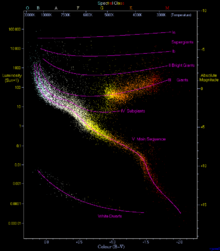Hertzsprung gap: Difference between revisions
Lithopsian (talk | contribs) stubsort |
m sp |
||
| Line 1: | Line 1: | ||
[[File:HRDiagram.png|thumb|right|[[Hertzsprung–Russell diagram]] with the |
[[File:HRDiagram.png|thumb|right|[[Hertzsprung–Russell diagram]] with the Hertzsprung Gap visible as an area containing few stars between the [[main sequence]] and [[red giant branch]]]] |
||
The '''Hertzsprung Gap''' is a feature of the [[Hertzsprung–Russell diagram]] for a star cluster. It is named after [[Ejnar Hertzsprung]], who first noticed the absence of stars in the region of the Hertzsprung–Russell diagram between A5 and G0 [[spectral type]] and between +1 and −3 [[absolute magnitude]]s (i.e. between the top of the [[main sequence]] and the [[red giant]]s for stars above roughly 1.5 [[solar mass]]. When a star during its [[Stellar evolution|evolution]] crosses the Hertzsprung gap, it means that it has finished [[Proton-proton chain reaction|core hydrogen burning]], but has yet to start hydrogen shell burning. |
The '''Hertzsprung Gap''' is a feature of the [[Hertzsprung–Russell diagram]] for a star cluster. It is named after [[Ejnar Hertzsprung]], who first noticed the absence of stars in the region of the Hertzsprung–Russell diagram between A5 and G0 [[spectral type]] and between +1 and −3 [[absolute magnitude]]s (i.e. between the top of the [[main sequence]] and the [[red giant]]s for stars above roughly 1.5 [[solar mass]]. When a star during its [[Stellar evolution|evolution]] crosses the Hertzsprung gap, it means that it has finished [[Proton-proton chain reaction|core hydrogen burning]], but has yet to start hydrogen shell burning. |
||
Revision as of 13:15, 13 October 2018

The Hertzsprung Gap is a feature of the Hertzsprung–Russell diagram for a star cluster. It is named after Ejnar Hertzsprung, who first noticed the absence of stars in the region of the Hertzsprung–Russell diagram between A5 and G0 spectral type and between +1 and −3 absolute magnitudes (i.e. between the top of the main sequence and the red giants for stars above roughly 1.5 solar mass. When a star during its evolution crosses the Hertzsprung gap, it means that it has finished core hydrogen burning, but has yet to start hydrogen shell burning.
Stars do exist in the Hertzsprung gap region, but because they move through this section of the Hertzsprung–Russell diagram very quickly in comparison to the lifetime of the star (thousands of years, compared to tens of billions of years for the lifetime of the star[1]), that portion of the diagram is less densely populated. Full Hertzsprung–Russell diagrams of the 11,000 Hipparcos mission targets show a handful of stars in that region.[2][failed verification]
References
